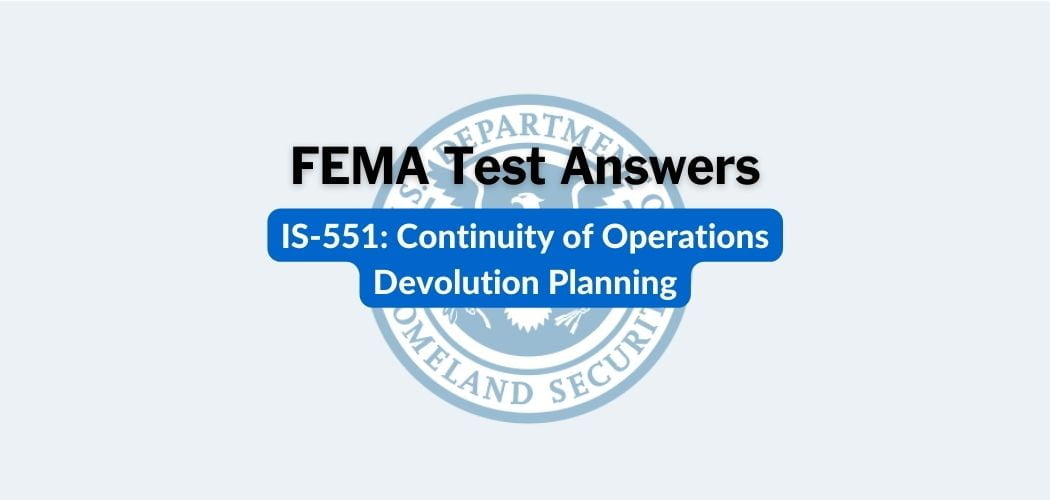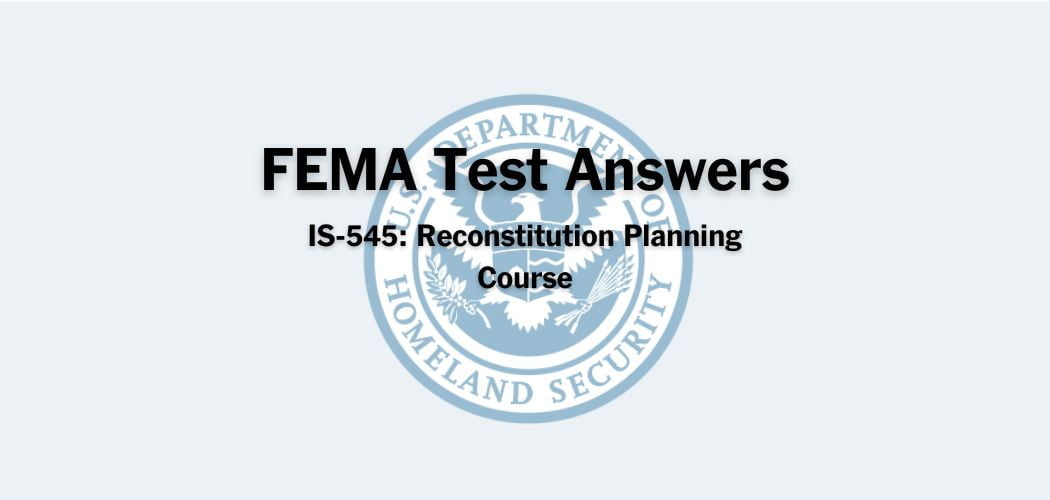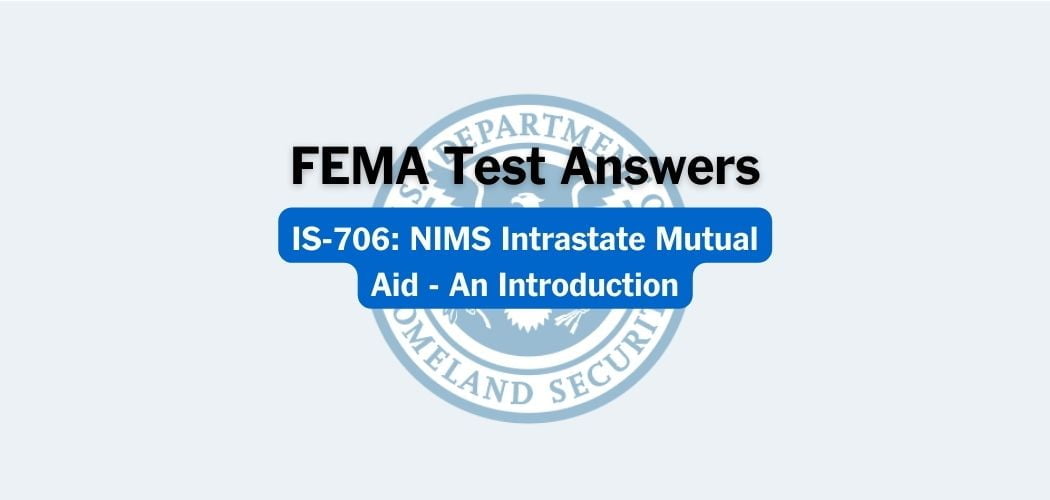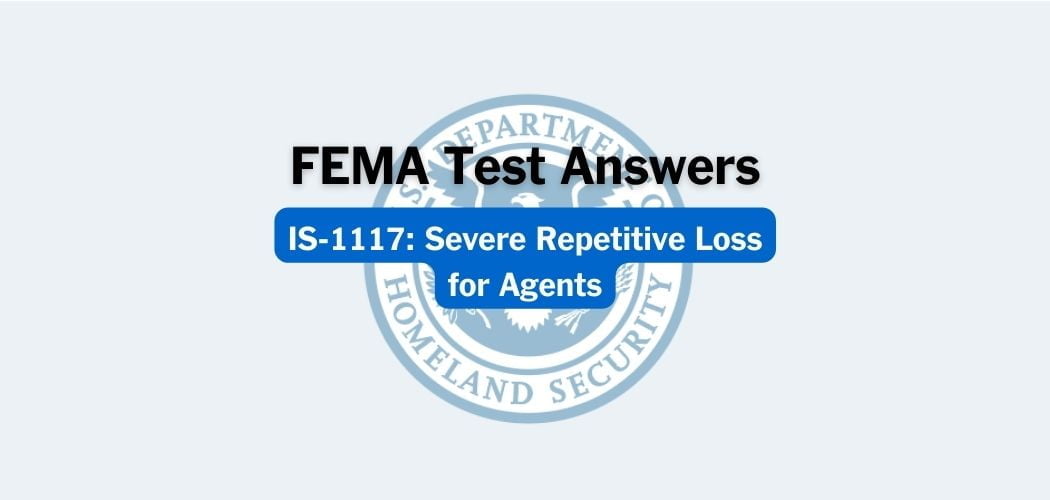Overview: The FEMA IS-317.A course was published on 5/1/2020 and is an introduction to the Community Emergency Response Team (CERT) program for those interested in learning about the CERT program for their own knowledge or as a pre-requisite for completing the CERT Basic classroom training that may be available in your community.
Primary audience: IS-317.A is for prospective CERT members. The course includes three lessons: Introduction to CERT; What CERTs Do; and, Becoming Involved.
FEMA IS-317.A test answers
Each time this test is loaded, you will receive a unique set of questions and answers. The test questions are scrambled to protect the integrity of the exam.
Question 1. Assessment of survivor injuries should be conducted in a systematic order from:
A. External to internal injuries
B. The back to the front
C. The head to the toes✅
D. The left side to the right
Question 2. Most bleeding can be controlled by:
A. Packing the wound with a salve
B. Immersing the wound in water
C. Covering the wound with ice
D. Direct pressure and elevation✅
Question 3. A CERT member finds herself near a possible terrorist incident and sees what she suspects is an explosive device. What should she do?
A. Use a cellular phone to report a suspected explosive device as quickly as possible
B. Leave the area and report information to 911 using a landline✅
C. Stay at the incident site to prevent unauthorized access
D. Investigate thoroughly to determine the likely type of weapon
Question 4. Two ways that CERT members prepare themselves and their families for disasters and emergencies are by identifying and reducing potential hazards in the home and workplace and by developing a family disaster plan. Which of the following is another way that CERT members prepare for disasters?
A. Ensuring evacuation routes are clear
B. Notifying authorities about known hazards
C. Restricting access to hazardous areas
D. Assembling disaster supply kits✅
Question 5. Kelly is the first member of her CERT to arrive at its predetermined staging area after a damaging wind storm struck her community. What role does Kelly now assume within her CERT?
A. Lead Responder
B. Designated Chief
C. Incident Commander✅
D. Sizeup Coordinator
Question 6. Which of the following describes the LIES procedures for storing flammable liquids?
A. Limit, Isolate, Eliminate, Separate✅
B. Limit, Identify, Eliminate, Secure
C. Lessen Individual Exposure and Sequester
D. Locate, Identify, Eradicate, Separate
Question 7. Which of the following is an effective strategy for eliminating or reducing potential fire hazards in the home and workplace?
A. Place extension cords beneath rugs so they do not become tripping hazards.
B. Store flammable liquids away from heat sources.✅
C. Install a fireplace screen that allows a fire to be left unattended.
D. Inspect wood stoves and chimney flues every five to seven years.
Question 8. To protect themselves against fluid-borne diseases, CERT members should:
A. Wash their hands for a minimum of 5 seconds
B. Wear a mask, exam gloves, and goggles✅
C. Disinfect every wound with hydrogen peroxide
D. Isolate each survivor in a separate treatment area
Question 9. The CERT Leader manages CERT operations until:
A. The Incident Command Post is established✅
B. The Operations Section Chief reports for duty
C. The Emergency Operations Plan is activated
D. The first professional responder arrives
Question 10. Triage is the process of sorting survivors according to the severity of their injuries. The triage process is especially effective in situations where:
A. There are more injured people than rescuers
B. There are limited resources
C. Time is critical
D. All of the above✅
Question 11. CERT member Gina is treating a burn survivor. Particles of the person’s clothing have adhered to the burn. What should Gina do?
A. Apply an antiseptic ointment on top of the adhered particles of clothing
B. Gently pull the adhered particles of clothing away from the burn
C. Leave the adhered particles of clothing in place✅
D. Irrigate the burn with potable water to loosen the adhered particles of clothing
Question 12. CERTs play a critical role in their communities by preparing for hazards and learning response skills to help themselves and others. Following a major disaster, CERTs may activate according to their standard operating procedures to:
A. Coordinate the response to a mass-casualty incident
B. Suppress major fires that may cause infrastructure damage
C. Respond to incidents in their neighborhoods or workplace✅
D. Assume lead responsibility in a hazardous materials incident
Question 13. When leveraging a heavy object to remove a survivor, remember to:
A. Stabilize the object with cribbing as you go✅
B. Lift the object very rapidly and drop it to one side
C. Leave the cribbing in place after removing the survivor
D. Place your hands under the object to raise it
Question 14. Bill and Madison are CERT members who are helping with disaster medical operations. They’re using personal protective equipment, including exam gloves. However, there aren’t enough gloves available for Bill and Madison to be able to change their gloves after treating each survivor. What should Bill and Madison do?
A. Dispose of their gloves when they become soiled, and then pour hydrogen peroxide over their hands after treating each survivor
B. Change their gloves only if they come in contact with body fluids
C. Dispose of their gloves when they become soiled, and then wash their hands with antibacterial soap for at least 15 seconds after treating each survivor
D. Disinfect their gloves after treating each survivor✅
Question 15. Sizeup is a cumulative process, and each step builds on previous steps. The first step is to:
A. Evaluate progress
B. Gather facts✅
C. Take action
D. Establish priorities
Question 16. The National Fire Protection Association (NFPA) 704 Diamond placard:
A. Lists the amount or quantity of hazardous materials in a container
B. Specifies the types of hazardous materials in a vehicle or rail car
C. Stipulates the proper storage procedures for hazardous materials
D. Indicates that hazardous materials are stored in the building✅
Question 17. When attempting to suppress a fire, CERT members should:
A. Feel heat before using an extinguisher
B. Work with a buddy and a backup team✅
C. Plan one escape route from the fire area
D. Open all doors as they leave the area
Question 18. During a disaster, survivors and helpers may experience disaster-related stress. Measures that CERT members can take to protect themselves from vicarious trauma include recognizing signs of trauma in themselves and taking breaks. Which of the following is another measure that CERT members can take to prevent vicarious trauma?
A. Don’t speak with survivors about their feelings of loss
B. Don’t over-identify with the survivors of the incident✅
C. Don’t respond to disasters that you have personally endured
D. Don’t remain at the scene for longer than 30 minutes
Question 19. A CERT member’s main objective when treating survivors with suspected head, neck, or spinal injuries is to:
A. Minimize swelling with the use of ice packs
B. Move the person as quickly as possible
C. Allow free movement of the neck and spine
D. Keep the spine in a straight line✅
Question 20. Which of the following will extinguish a Class A, B, or C fire?
A. Water extinguisher
B. Dry chemical extinguisher✅
C. Specialized extinguisher
D. Carbon dioxide extinguisher
Question 21. CERT members should always wear complete safety equipment, including:
A. Backpack containing a portable fire extinguisher
B. Breathing apparatus for smoke-filled rooms or areas
C. Helmet, sturdy shoes or boots, goggles, work gloves, and a dust mask✅
D. Specialized equipment for hazardous materials
Question 22. The three life-threatening conditions that always get first priority are obstructed airway, excessive bleeding, and:
A. Nausea
B. Shock✅
C. Dizziness
D. Headache
Question 23. All survivors who have third-degree burns should also be treated for which one of the following conditions?
A. Hypothermia
B. Shock✅
C. Vicarious trauma
D. Obstructed airway
Question 24. Which of the following is NOT part of the CERT member’s goal when working to do the greatest good for the greatest number of survivors?
A. Triage survivors
B. Treat the most serious injuries first
C. Retreat immediately and wait for professionals✅
D. Size up the situation
Question 25. To indicate the results of triage, every person receives a:
A. Wrist band marked “L” for life-threatening injuries, “S” for severe injuries, and “M” for minor injuries
B. Hand stamp marking the person as “#1” for first priority level, “#2” for second priority level, or “#3” for third priority level
C. Tag that indicates whether the person requires immediate treatment, can receive delayed treatment, has only minor injuries, or is dead✅
D. Color-coded armband that indicates whether the person should be released (green), observed (yellow), or sent for immediate treatment (red)
Question 26. CERT members responding to an incident suspect that they have been contaminated by exposure to a chemical agent. They follow the basic self-decontamination procedures to reduce their risk of injury and limit their exposure to the chemical. What should they do next?
A. Stay out of the contaminated area and wait for professional responders to conduct formal decontamination✅
B. Conduct the same decontamination procedures on the other survivors at the scene
C. Relocate downwind of the contaminated site and set up a medical treatment area
D. Stay in the contaminated area to provide medical treatment to the survivors
Question 27. A thorough size up can make CERT response safer and more efficient by:
A. Eliminating the need for professional responders
B. Determining the estimated response time before taking action
C. Prioritizing actions based on team safety and capability✅
D. Providing critical information to the public
Question 28. Sandy, a CERT member who is assisting with disaster medical operations, finds a person who appears to be in shock. Which of the following is NOT a sign that the person may be in shock?
A. Rapid breathing
B. Failure to respond
C. Convulsions✅
D. Slow capillary refill
Question 29. Survivors go through four emotional phases when a disaster occurs. In order, they are:
A. Impact phase, inventory phase, rescue phase, the recovery phase✅
B. Inventory phase, rescue phase, imprint phase, resource phase
C. Recall phase, injury phase, impact phase, rescue phase
D. Injury phase, imprint phase, recall phase, the recovery phase
Question 30. A clearly marked _____ helps responders efficiently treat survivors.
A. Fence
B. CERT command post
C. Medical treatment area✅
D. Map
Question 31. Fires are classified according to:
A. The type of structure involved
B. The severity of the fire
C. The location of the fire
D. The type of fuel feeding the fire✅
Question 32. CERT search and rescue teams must never:
A. Use a buddy system
B. Perform a sizeup of the situation
C. Work during periods of rainy weather
D. Enter heavily damaged structures✅
Question 33. Which of the following describes what CERT members should do periodically as they search for survivors inside a damaged building?
A. Synchronize their watches
B. Stop all movement and listen for sounds of trapped survivors✅
C. Verify that they still have visual contact with the Team Leader
D. Switch positions with their buddies
Question 34. All CERT decisions are made with what key question in mind?
A. Is it safe for CERT members to attempt this task?✅
B. How quickly can the CERT assist the survivors?
C. Who is the Incident Commander in this situation?
D. When will professional responders arrive at the scene?
Question 35. CERTs should attempt to suppress only fires that are smaller than the size of a:
A. Wastepaper can✅
B. Woodshed
C. Couch or sofa
D. Pickup truck
Question 36. Craig, a CERT member, is conducting triage of a survivor. He has checked her airway/breathing and bleeding/circulation. What should he do next?
A. Give the survivor a tag to identify her triage category
B. Check the survivor’s mental status✅
C. Report his findings to the chief medical professional in the medical treatment area
D. Escort the survivor into the decontamination area
Question 37. How does assessment of structural damage during sizeup affect search and rescue operations?
A. The CERT mission changes, depending on whether the damage is light, moderate, or heavy✅
B. CERT members need to use additional protective equipment before entering a heavily damaged structure
C. Depending on the type of damage, emergency medical personnel may have to accompany a CERT when the team goes inside the structure
D. CERTs are not allowed to enter either moderately or heavily damaged structures
Question 38. A CERT is searching for survivors in a building after an electrical storm. The door to one of the rooms that the team needs to search is closed. Some of the CERT members think they smell smoke. Before entering the closed room, what should the CERT members do?
A. Cover their mouths and noses to keep from inhaling smoke
B. Touch the door handle to feel if it’s hot
C. Feel the closed door with the back of the hand, from the bottom up✅
D. Have a fire extinguisher ready before opening the door
Question 39. CERT members respond to an incident in which a truck that’s carrying a known hazardous material has overturned on a highway. What should the team do?
A. Stay at the incident site to conduct a size up
B. Consider the hazardous material a STOP sign✅
C. Conduct decontamination of other survivors
D. Move downwind of the initial incident site
Question 40. Connie and Deb are CERT buddies who are assisting with disaster medical operations. All survivors in the area have been triaged and treated for any life-threatening injuries. What should Connie and Deb do next?
A. Collect contact information to notify relatives of survivors who have died
B. Treat the next priority survivors✅
C. Disinfect the medical treatment area
D. Begin head-to-toe survivor assessments



